Simultaneous Action of X- and O-Mode HF Pump Waves on the High-Latitude Upper (F-Region) Ionosphere at EISCAT
Abstract
:1. Introduction
2. Experiment and Instrumentation
3. Results and Analysis
3.1. Behavior and Features of the Stimulated Electromagnetic Emission and Small-Scale Artificial Field-Aligned Irregularities
3.2. Plasma Parameter Changes
3.3. Langmuir and Ion-Acoustic Plasma Waves
4. Discussion
5. Conclusions
Author Contributions
Funding
Institutional Review Board Statement
Informed Consent Statement
Data Availability Statement
Acknowledgments
Conflicts of Interest
References
- Grach, S.M.; Trakhtengerts, V.Y. Parametric excitation of ionospheric irregularities extended along the magnetic field. Radiophys. Quant. Electron. 1975, 18, 951–957. [Google Scholar] [CrossRef]
- Gurevich, A.V. Nonlinear effects in the ionosphere. Phys.-Uspekhi 2007, 50, 1091–1121. [Google Scholar] [CrossRef]
- Kuo, S.P. Overview of Ionospheric Modification by High Frequency (HF) Heaters-Theory. Prog. Electromagn. Res. B 2014, 60, 141–155. [Google Scholar] [CrossRef] [Green Version]
- DuBois, D.F.; Rose, H.A.; Russell, D. Space and time distribution of HF excited Langmuir turbulence in the ionosphere: Comparison of theory and experiment. J. Geophys. Res. 1993, 98, 17543–17567. [Google Scholar] [CrossRef]
- Minkoff, J.; Kugelman, P.; Weissman, I. Radio frequency scattering from a heated ionospheric volume, 1, VHF/UHF field-aligned and plasma-line backscatter measurements. Radio Sci. 1974, 9, 941–955. [Google Scholar] [CrossRef]
- Bond, G.E.; Robinson, T.R.; Eglitis, P.; Wright, D.M.; Stocker, A.J.; Rietveld, M.T.; Jones, T.B. Spatial observations by the CUTLASS coherent scatter radar of ionospheric modification by high power radio waves. Ann. Geophys. 1997, 15, 1412–1421. [Google Scholar] [CrossRef]
- Wright, D.M.; Davies, J.A.; Yeoman, T.K.; Robinson, T.R.; Shergill, H. Saturation and hysteresis effects in ionospheric modification experiments observed by the CUTLASS and EISCAT radars. Ann. Geophys. 2006, 24, 543–553. [Google Scholar] [CrossRef] [Green Version]
- Streltsov, A.V.; Berthelier, J.-J.; Chernyshov, A.A.; Frolov, V.L.; Honary, F.; Kosch, M.J.; McCoy, R.P.; Mishin, E.V.; Rietveld, M.T. Past, Present and Future of Active Radio Frequency Experiments in Space. Space Sci. Rev. 2018, 214, 118. [Google Scholar] [CrossRef] [Green Version]
- Rietveld, M.T.; Kosch, M.T.; Blagoveshchenskaya, N.F.; Kornienko, V.A.; Leyser, T.B.; Yeoman, T.M. Ionospheric electron heating, optical emissions, and striations induced by powerful HF radio waves at high latitudes: Aspect angle dependence. J. Geophys. Res. 2003, 108, 1141–1156. [Google Scholar] [CrossRef] [Green Version]
- Thidé, B.; Kopka, H.; Stubbe, P. Observations of stimulated scattering of a strong high frequency radio wave in the ionosphere. Phys. Rev. Lett. 1982, 49, 1561–1564. [Google Scholar] [CrossRef]
- Leyser, T.B. Stimulated electromagnetic emissions by high-frequency electromagnetic pumping of the ionospheric plasma. Space Sci. Rev. 2001, 98, 223–328. [Google Scholar] [CrossRef]
- Norin, L.; Leyser, T.B.; Nordblad, E.; Thidé, B.; McCarrick, M. Unprecedentedly strong and narrow electromagnetic emissions stimulated by high-frequency radio waves in the ionosphere. Phys. Rev. Lett. 2009, 102, 065003. [Google Scholar] [CrossRef] [PubMed]
- Bernhardt, P.A.; Selcher, C.A.; Kowtha, S. Electron and ion Bernstein waves excited in the ionosphere by high power EM waves at the second harmonic of the electron cyclotron frequency. Geophys. Res. Lett. 2011, 38, L.19107. [Google Scholar] [CrossRef]
- Brandstrom, B.U.E.; Leyser, T.B.; Steen, A.; Rietveld, M.T.; Gustavsson, B.; Aso, T.; Ejiri, M. Unambiguous evidence of HFpump-enhanced airglow. Geophys. Res. Lett. 1999, 26, 3561–3564. [Google Scholar] [CrossRef]
- Pedersen, T.; Carlson, H. First observations of HF heater-produced airglow at the High Frequency Active Auroral ResearchProgram facility: Thermal excitation and spatial structuring. Radio Sci. 2001, 36, 1013–1026. [Google Scholar] [CrossRef]
- Robinson, T.R. The heating of the high latitude ionosphere by high power radio waves. Phys. Rep. 1989, 179, 79–209. [Google Scholar] [CrossRef]
- Graham, K.N.; Fejer, J.A. Anomalous radio wave absorption due to ionospheric heating effects. Radio Sci. 1976, 11, 1057–1063. [Google Scholar] [CrossRef]
- Stubbe, P.; Kohl, H.; Rietveld, M.T. Langmuir turbulence and ionospheric modification. J. Geophys. Res. 1992, 97, 6285–6297. [Google Scholar] [CrossRef]
- Mishin, E.; Watkins, B.; Lehtinen, N.; Eliasson, B.; Pedersen, T.; Grach, S. Artificial ionospheric layers driven by high-frequency radiowaves: An assessment. J. Geophys. Res. Space Phys. 2016, 121, 3497–3524. [Google Scholar] [CrossRef] [Green Version]
- Blagoveshchenskaya, N.F.; Borisova, T.D.; Yeoman, T.; Rietveld, M.T.; Ivanova, I.M.; Baddeley, L.J. Artificial field-aligned irregularities in the high-latitude F region of the ionosphere induced by an X-mode HF heater wave. Geophys. Res. Lett. 2011, 38, L08802. [Google Scholar] [CrossRef]
- Blagoveshchenskaya, N.F.; Borisova, T.D.; Kosch, M.; Sergienko, T.; Brändström, U.; Yeoman, T.K.; Häggström, I. Optical and Ionospheric Phenomena at EISCAT under Continuous X-mode HF Pumping. J. Geophys. Res. Space Phys. 2014, 119, 10483–10498. [Google Scholar] [CrossRef]
- Blagoveshchenskaya, N.F.; Borisova, T.D.; Yeoman, T.K. Comment on the article “Parametric Instability Induced by X-Mode Wave Heating at EISCAT” by Wang et al. 2016. J. Geophys. Res. Space Phys. 2017, 122, 12570–12586. [Google Scholar] [CrossRef] [Green Version]
- Blagoveshchenskaya, N.F.; Borisova, T.D.; Kalishin, A.S.; Yeoman, T.K.; Häggström, I. Distinctive features of Langmuir and Ion-acoustic Turbulences induced by O- and X-mode HF Pumping at EISCAT. J. Geophys. Res. Space Phys. 2020, 125, e2020JA028203. [Google Scholar] [CrossRef]
- Blagoveshchenskaya, N.F.; Borisova, T.D.; Yeoman, T.K.; Rietveld, M.T.; Häggström, I.; Ivanova, I.M. Plasma modifications induced by an X-mode HF heater wave in the high latitude F region of the ionosphere. J. Atmos. Sol. Terr. Phys. 2013, 105–106, 231–244. [Google Scholar] [CrossRef] [Green Version]
- Blagoveshchenskaya, N.F.; Borisova, T.D.; Yeoman, T.K.; Häggström, I.; Kalishin, A.S. Modification of the high latitude ionosphere F region by X-mode powerful HF radio waves: Experimental results from multi-instrument diagnostics. J. Atmos. Solar-Terr. Phys. 2015, 135, 50–63. [Google Scholar] [CrossRef] [Green Version]
- Blagoveshchenskaya, N.F.; Borisova, T.D.; Kalishin, A.S.; Yeoman, T.K.; Häggström, I. First observations of electron gyro-harmonic effects under X-mode HF pumping the high latitude ionospheric F-region. J. Atmos. Solar-Terr. Phys. 2017, 155, 36–49. [Google Scholar] [CrossRef] [Green Version]
- Kalishin, A.S.; Blagoveshchenskaya, N.F.; Borisova, T.D.; Yeoman, T.K. Ion Gyro-Harmonic Structures in Stimulated Emission Excited by X-Mode High Power HF Radio Waves at EISCAT. J.Geophys. Res. Space Phys. 2021, 126, e2020JA028989. [Google Scholar] [CrossRef]
- Borisova, T.D.; Blagoveshchenskaya, N.F.; Yeoman, T.K.; Häggström, I. Excitation of artificial turbulence in the high-latitude ionospheric F region as a function of the EISCAT/Heating effective radiated. Radiophys. Quant. Electron. 2017, 60, 273–290. [Google Scholar] [CrossRef]
- Blagoveshchenskaya, N.F.; Borisova, T.D.; Kalishin, A.S.; Kayatkin, V.N.; Yeoman, T.K.; Häggström, I. Comparison of the Effects Induced by the Ordinary (O-Mode) and Extraordinary (X-Mode) Polarized Powerful HF Radio Waves in the High-Latitude Ionospheric F Region. Cosm. Res. 2018, 56, 11–25. [Google Scholar] [CrossRef]
- Blagoveshchenskaya, N.F.; Borisova, T.D.; Kalishin, A.S.; Yeoman, T.K.; Schmelev, Y.A.; Leonenko, E.E. Characterization of Artificial, Small-Scale, Ionospheric Irregularities in the High-Latitude F Region Induced by High-Power, High-Frequency Radio Waves of Extraordinary Polarization. Geomagn. Aeron. 2019, 59, 759–773. [Google Scholar] [CrossRef]
- Blagoveshchenskaya, N.F. Perturbing the high-latitude upper ionosphere (F region) with powerful HF radio waves: A 25-year collaboration with EISCAT. URSI Radio Sci. Bull. 2020, 2020, 40–55. [Google Scholar] [CrossRef]
- Rietveld, M.T.; Senior, A.; Markkanen, J.; Westman, A. New capabilities of the upgraded EISCAT high-power HF facility. Radio Sci. 2016, 51, 1533–1546. [Google Scholar] [CrossRef] [Green Version]
- Wang, X.; Zhou, C.; Xu, T.; Honary, F.; Rietveld, M.; Frolov, V. Stimulated electromagnetic emissions spectrum observed during an X-mode heating experiment at the European Incoherent Scatter Scientific Association. Earth Planet. Phys. 2019, 3, 391–399. [Google Scholar] [CrossRef]
- Lester, M.; Chapman, P.J.; Cowley, S.W.H.; Crooks, S.J.; Davies, J.A.; Hamadyk, P.; McWilliams, K.A.; Milan, S.E.; Parsons, M.J.; Payne, D.B.; et al. Stereo CUTLASS: A new capability for the Super DARN radars. Ann. Geophys. 2004, 22, 459–473. [Google Scholar] [CrossRef] [Green Version]
- Rishbeth, H.; Eyken, T. EISCAT: Early history and the first ten years of operation. J. Atmos. Solar-Terr. Phys. 1993, 55, 525–542. [Google Scholar] [CrossRef]
- Lehtinen, M.S.; Huuskonen, A. General incoherent scatter analysis and GUISDAP. J Atmos. Solar-Terr. Phys. 1996, 58, 435–452. [Google Scholar] [CrossRef]
- Stubbe, P. Review of ionospheric modification experiments at Tromso. J. Atmos. Solar-Terr. Phys. 1996, 58, 349–368. [Google Scholar] [CrossRef]
- Bryers, C.J.; Kosch, M.J.; Senior, A.; Rietveld, M.T.; Singer, W. A comparison between resonant and nonresonant heating at EISCAT. J. Geophys. Res. Space Phys. 2013, 118, 6766–6776. [Google Scholar] [CrossRef] [Green Version]
- Bernhardt, P.A.; Selcher, C.A.; Lehmberg, R.H.; Rodriguez, S.P.; Thomason, J.F.; Groves, K.M.; McCarrick, M.J.; Frazer, G.J. Stimulated Brillouin Scatter in a magnetized ionospheric plasma. Phys. Rev. Lett. 2010, 104, 165004. [Google Scholar] [CrossRef]
- Borisova, T.D.; Blagoveshchenskaya, N.F.; Kalishin, A.S.; Kosch, M.; Senior, A.; Rietveld, M.T.; Yeoman, T.K.; Hagstrom, I. Phenomena in the high-latitude ionospheric F region induced by a HF heater wave at frequencies near the fourth electron gyroharmonic. Radiophys. Quant. Electr. 2014, 57, 1–19. [Google Scholar] [CrossRef]
- Fu, H.Y.; Jiang, M.L.; Wang, K.N.; Wu, J.; Li, Q.L.; Rietveld, M.T.; Varberg, E.; Haggstrom, I.; Jin, Y.Q. Electron Temperature Inversion by Stimulated Brillouin Scattering During Electron Gyro-Harmonic Heating at EISCAT. Geophys. Res. Lett. 2020, 47, e2020GL089747. [Google Scholar] [CrossRef]
- Mahmoudian, A.; Scales, W.A.; Bernhardt, P.A.; Fu, H.; Briczinski, S.J.; McCarrick, M.J. Investigation of ionospheric stimulated Brillouin scatter generated at pump frequencies near electron gyroharmonics. Radio Sci. 2013, 48, 685–697. [Google Scholar] [CrossRef]
- Samimi, A.; Scales, W.A.; Fu, H.; Bernhardt, P.A.; Briczinski, S.J.; McCarrick, M.J. Ion gyroharmonic structures in stimulated radiation during second electron gyroharmonic heating: 1. Theory. J. Geophys. Res. Space Phys. 2013, 118, 502–514. [Google Scholar] [CrossRef]
- Samimi, A.; Scales, W.A.; Bernhardt, P.A.; Briczinski, S.J.; McCarrick, M.J. Ion gyroharmonic structures in stimulated radiation during second electron gyroharmonic heating: 2. Simulations. J. Geophys. Res. Space Phys. 2014, 119, 462–478. [Google Scholar] [CrossRef]
- Wu, J.; Blagoveshchenskaya, N.F.; Wu, J.; Rietveld, M.T.; Häggström, I. Descents in high-frequency enhanced plasma and ion lines during ionospheric heating at EISCAT. J. Atmos. Solar-Terr. Phys. 2021, 212, 105425. [Google Scholar] [CrossRef]
- Ashrafi, M.; Kosch, M.; Honary, F. Heater-induced altitudedescent of the EISCAT UHF ion line enhancements: Observations and modeling. Adv. Space Res. 2006, 38, 2645–2652. [Google Scholar] [CrossRef] [Green Version]
- Dhillon, R.S.; Robinson, T.R. Observations of time dependence and aspect sensitivity of regions of enhanced UHF backscatter associated with RF heating. Ann. Geophys. 2005, 23, 75–85. [Google Scholar] [CrossRef] [Green Version]
- Jones, T.B.; Robinson, T.R.; Stubbe, P.; Kopka, H. EISCATobservations of the heated ionosphere. J. Atmos. Solar-Terr. Phys. 1986, 48, 1027–1035. [Google Scholar] [CrossRef]
- Bryers, C.; Kosch, M.; Senior, A.; Rietveld, M.T.; Yeoman, T.K. The thresholds of ionospheric plasma instabilities pumped by high-frequency radio waves at EISCAT. J. Geophys. Res. Space Phys. 2013, 118, 7472–7481. [Google Scholar] [CrossRef] [Green Version]
- Mishin, E.; Hagfors, T.; Kofman, W. On origin of outshifted plasma lines during HF modification experiments. J. Geophys. Res. 1997, 102, 27265–27269. [Google Scholar] [CrossRef]
- Rietveld, M.T.; Isham, B.; Kohl, H.; Hoz, C.L.; Hagfors, T. Measurements of HF-enhanced plasma and ion lines at EISCAT with high altitude resolution. J. Geophys. Res. 2000, 105, 7429–7439. [Google Scholar] [CrossRef]
- Borisova, T.D.; Blagoveshchenskaya, N.F.; Rietveld, M.T.; Häggström, I. Outshifted plasma lines observed in Heating experiments in the high-latitude ionosphere at pump frequencies near electron gyroharmonic. Radiophys. Quant. Electr. 2019, 61, 722–740. [Google Scholar] [CrossRef]
- Fejer, J.A. Ionospheric Modification and Parametric Instabilities. Rev. Geophys. Space Phys. 1979, 17, 135–153. [Google Scholar] [CrossRef]
- Stubbe, P.H.; Kopka, H. Exploration of the Polar upper Atmosphere: Proceedings of the Nato Advanced Study Institute; Deehr, C.S., Holtet, J.A., Eds.; Springer: Dordrecht, The Netherlands, 1981. [Google Scholar] [CrossRef]
- Picone, J.M.; Hedin, A.E.; Drob, D.P.; Aikin, A.C. NRLMSISE-00 empirical model of the atmosphere: Statistical comparisons and scientific issues. J. Geophys. Res. 2002, 107, 1468. [Google Scholar] [CrossRef]


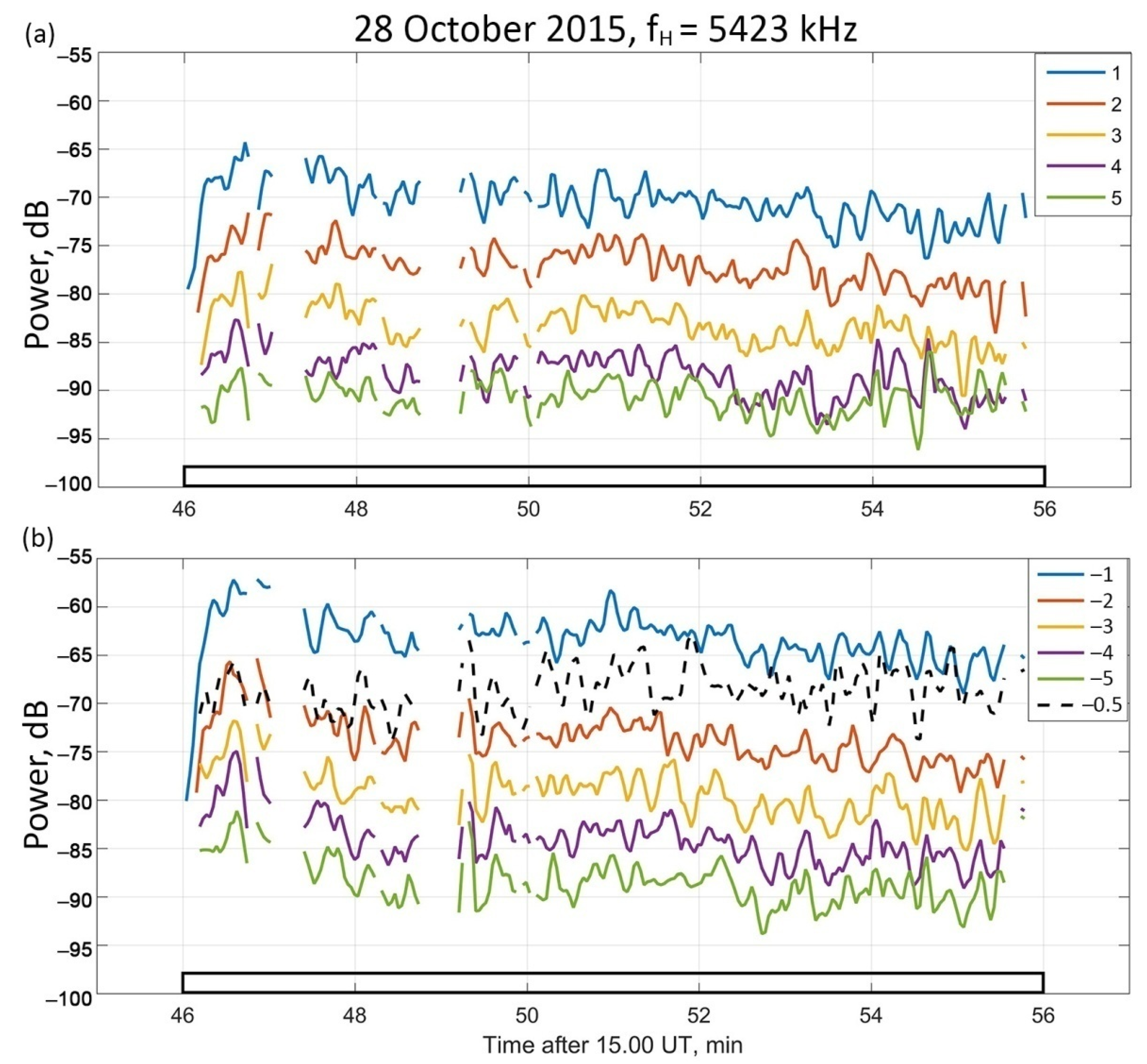
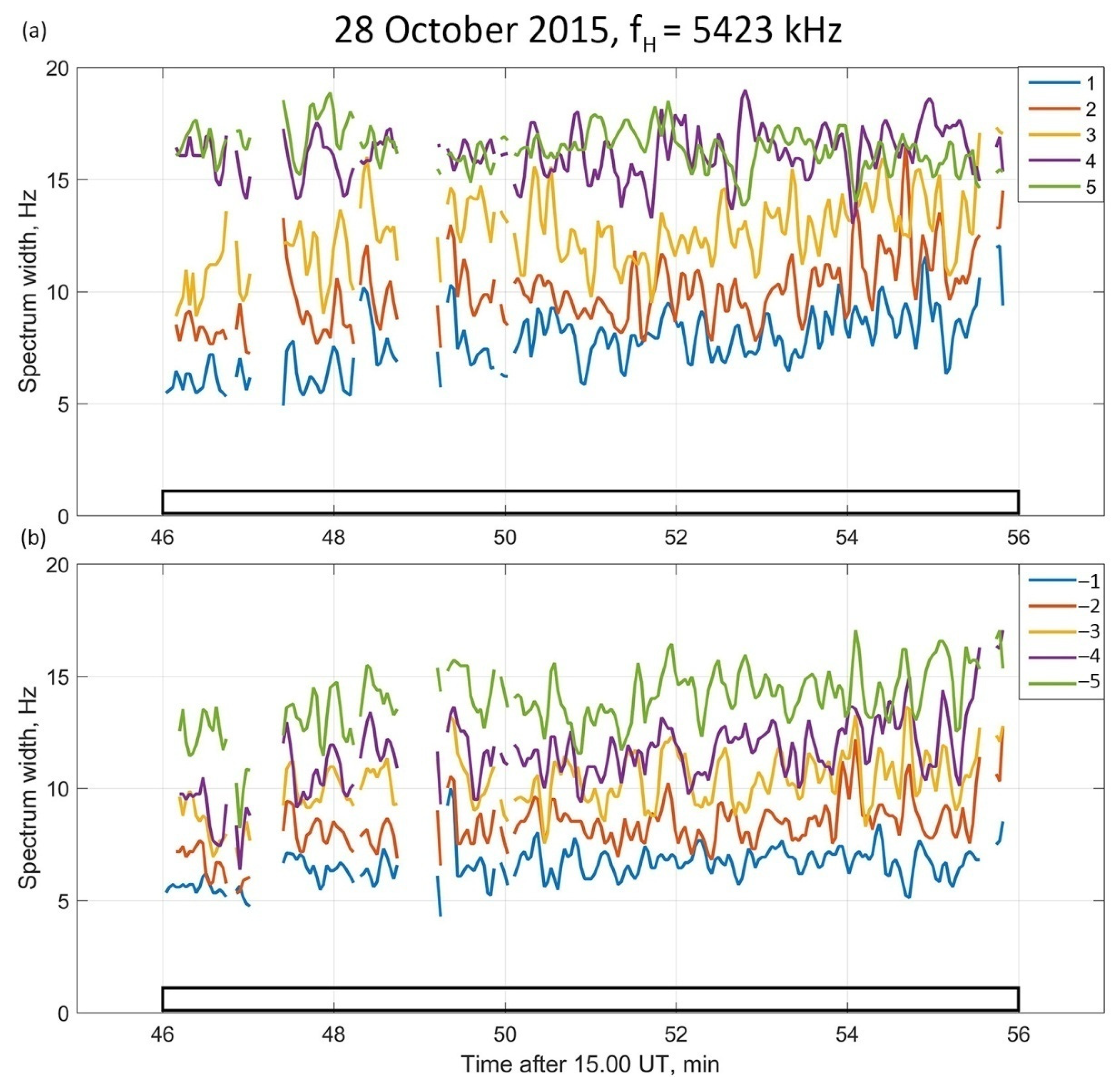

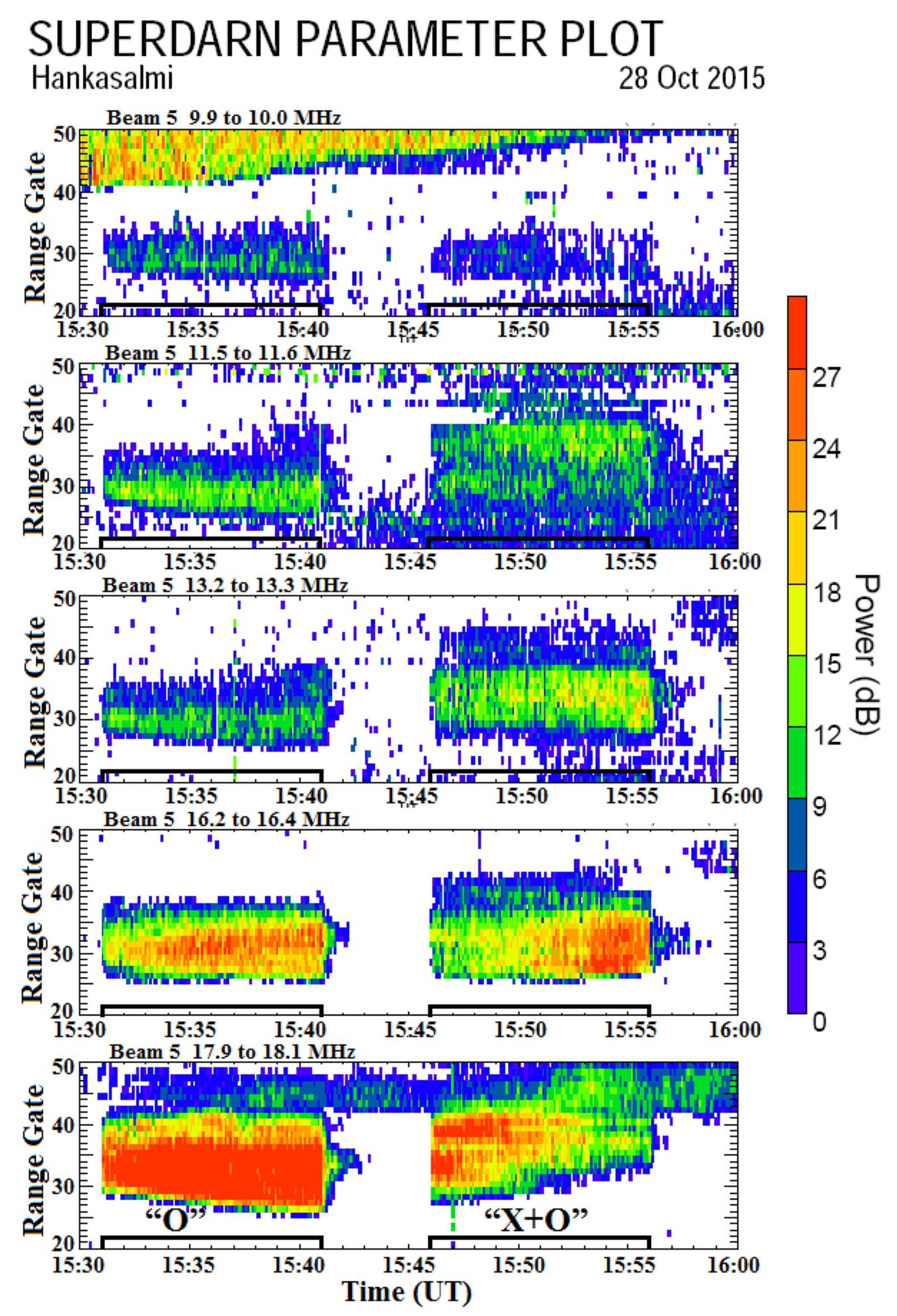


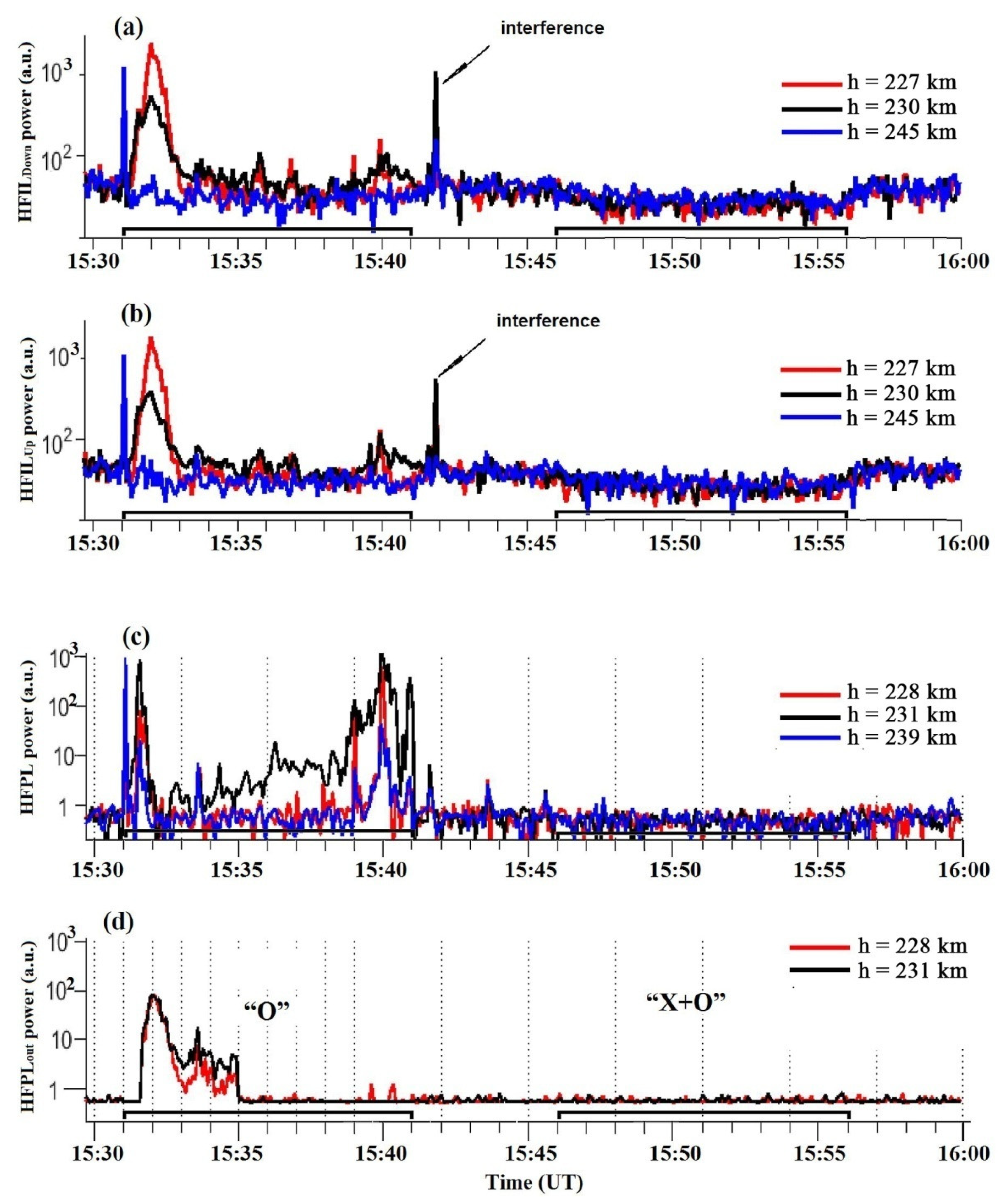

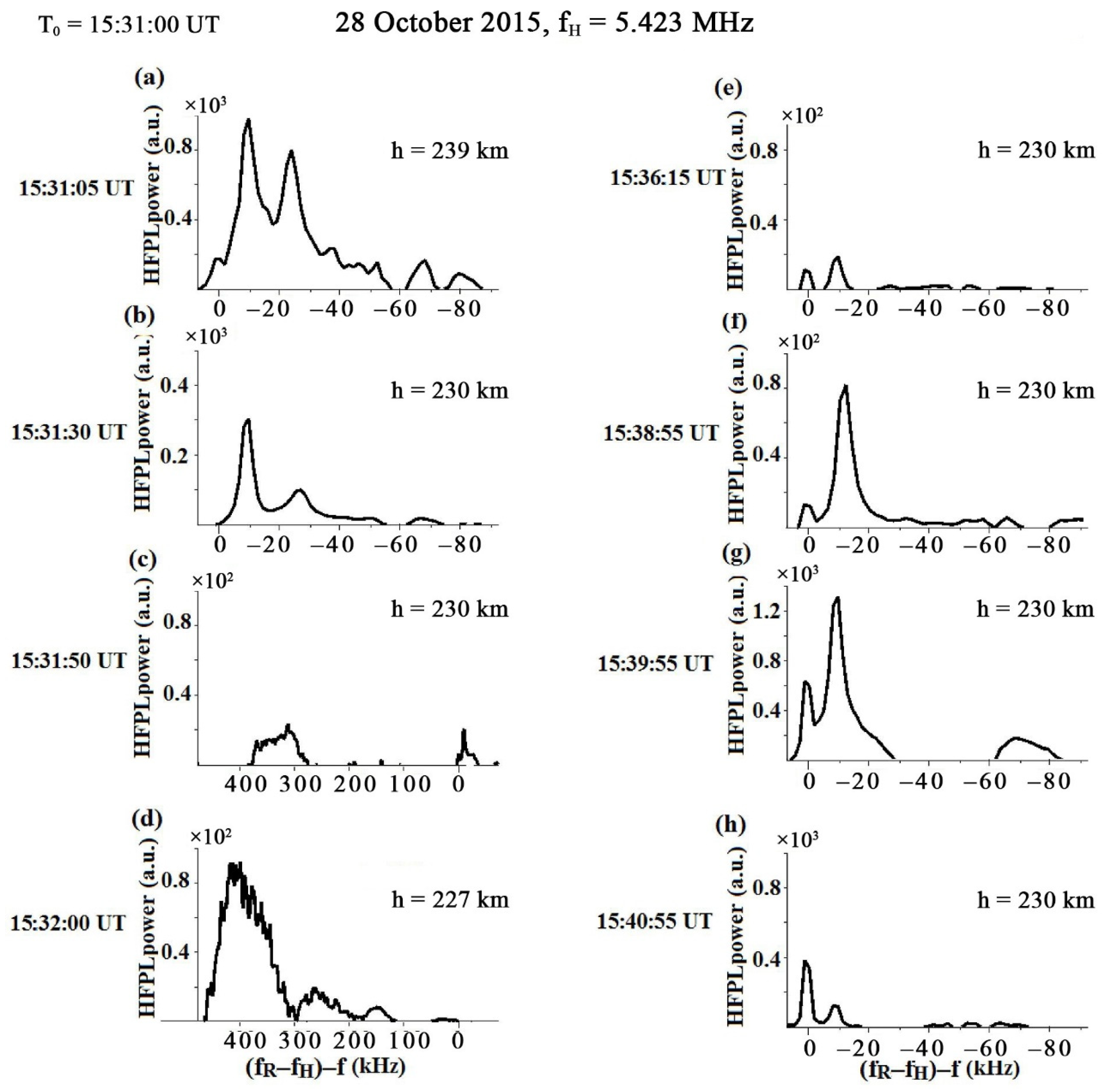
Publisher’s Note: MDPI stays neutral with regard to jurisdictional claims in published maps and institutional affiliations. |
© 2022 by the authors. Licensee MDPI, Basel, Switzerland. This article is an open access article distributed under the terms and conditions of the Creative Commons Attribution (CC BY) license (https://creativecommons.org/licenses/by/4.0/).
Share and Cite
Blagoveshchenskaya, N.; Borisova, T.; Kalishin, A.; Egorov, I.; Yeoman, T.; Haggstrom, I. Simultaneous Action of X- and O-Mode HF Pump Waves on the High-Latitude Upper (F-Region) Ionosphere at EISCAT. Universe 2022, 8, 91. https://doi.org/10.3390/universe8020091
Blagoveshchenskaya N, Borisova T, Kalishin A, Egorov I, Yeoman T, Haggstrom I. Simultaneous Action of X- and O-Mode HF Pump Waves on the High-Latitude Upper (F-Region) Ionosphere at EISCAT. Universe. 2022; 8(2):91. https://doi.org/10.3390/universe8020091
Chicago/Turabian StyleBlagoveshchenskaya, Nataly, Tatiana Borisova, Alexey Kalishin, Ivan Egorov, Tim Yeoman, and Ingemar Haggstrom. 2022. "Simultaneous Action of X- and O-Mode HF Pump Waves on the High-Latitude Upper (F-Region) Ionosphere at EISCAT" Universe 8, no. 2: 91. https://doi.org/10.3390/universe8020091





